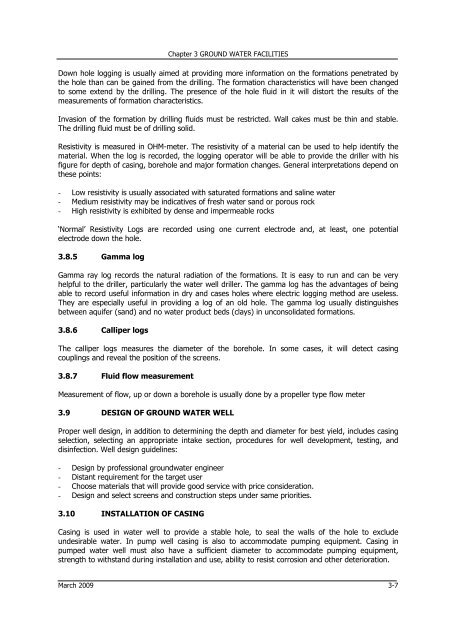Volume 8 – Mechanical and Electrical Services - Malaysia Geoportal
Volume 8 – Mechanical and Electrical Services - Malaysia Geoportal
Volume 8 – Mechanical and Electrical Services - Malaysia Geoportal
You also want an ePaper? Increase the reach of your titles
YUMPU automatically turns print PDFs into web optimized ePapers that Google loves.
Chapter 3 GROUND WATER FACILITIES<br />
Down hole logging is usually aimed at providing more information on the formations penetrated by<br />
the hole than can be gained from the drilling. The formation characteristics will have been changed<br />
to some extend by the drilling. The presence of the hole fluid in it will distort the results of the<br />
measurements of formation characteristics.<br />
Invasion of the formation by drilling fluids must be restricted. Wall cakes must be thin <strong>and</strong> stable.<br />
The drilling fluid must be of drilling solid.<br />
Resistivity is measured in OHM-meter. The resistivity of a material can be used to help identify the<br />
material. When the log is recorded, the logging operator will be able to provide the driller with his<br />
figure for depth of casing, borehole <strong>and</strong> major formation changes. General interpretations depend on<br />
these points:<br />
- Low resistivity is usually associated with saturated formations <strong>and</strong> saline water<br />
- Medium resistivity may be indicatives of fresh water s<strong>and</strong> or porous rock<br />
- High resistivity is exhibited by dense <strong>and</strong> impermeable rocks<br />
‘Normal’ Resistivity Logs are recorded using one current electrode <strong>and</strong>, at least, one potential<br />
electrode down the hole.<br />
3.8.5 Gamma log<br />
Gamma ray log records the natural radiation of the formations. It is easy to run <strong>and</strong> can be very<br />
helpful to the driller, particularly the water well driller. The gamma log has the advantages of being<br />
able to record useful information in dry <strong>and</strong> cases holes where electric logging method are useless.<br />
They are especially useful in providing a log of an old hole. The gamma log usually distinguishes<br />
between aquifer (s<strong>and</strong>) <strong>and</strong> no water product beds (clays) in unconsolidated formations.<br />
3.8.6 Calliper logs<br />
The calliper logs measures the diameter of the borehole. In some cases, it will detect casing<br />
couplings <strong>and</strong> reveal the position of the screens.<br />
3.8.7 Fluid flow measurement<br />
Measurement of flow, up or down a borehole is usually done by a propeller type flow meter<br />
3.9 DESIGN OF GROUND WATER WELL<br />
Proper well design, in addition to determining the depth <strong>and</strong> diameter for best yield, includes casing<br />
selection, selecting an appropriate intake section, procedures for well development, testing, <strong>and</strong><br />
disinfection. Well design guidelines:<br />
- Design by professional groundwater engineer<br />
- Distant requirement for the target user<br />
- Choose materials that will provide good service with price consideration.<br />
- Design <strong>and</strong> select screens <strong>and</strong> construction steps under same priorities.<br />
3.10 INSTALLATION OF CASING<br />
Casing is used in water well to provide a stable hole, to seal the walls of the hole to exclude<br />
undesirable water. In pump well casing is also to accommodate pumping equipment. Casing in<br />
pumped water well must also have a sufficient diameter to accommodate pumping equipment,<br />
strength to withst<strong>and</strong> during installation <strong>and</strong> use, ability to resist corrosion <strong>and</strong> other deterioration.<br />
March 2009 3-7

















